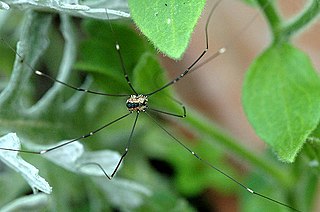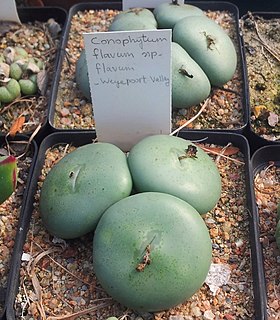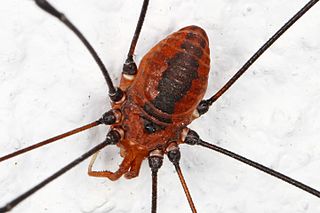
Zanthoxylum flavum is a medium-sized tree in the family Rutaceae. Common names include noyer, West Indian satinwood, yellow sanders, tembetaria, and yellow sandalwood. It is native to Anguilla, Antigua and Barbuda, the Bahamas, Bermuda, Cuba, the Dominican Republic, Guadeloupe, Haiti, Jamaica, Puerto Rico, and the Florida Keys, exclusive of Key West where it has been extirpated. It is threatened by habitat loss and harvesting for its dense, durable wood used in fine woodworking.

Leiobunum is a genus of the harvestman family Sclerosomatidae with more than a hundred described species. Contrary to popular belief, they are not spiders, although they share a resemblance. They are arachnids, in the order Opiliones, harvestmen. Species in Leiobunum tend to have relatively long legs compared with other harvestmen, and some species are gregarious.

Leiobunum rotundum is a species of harvestman. It is found in the western Old World.

Thalictrum flavum, known by the common names common meadow-rue, and yellow meadow-rue, is a flowering plant species in the family Ranunculaceae. It is a native to Caucasus and Russia (Siberia). Growing to 100 cm (39 in) tall by 45 cm (18 in) broad, it is an herbaceous perennial producing clusters of fluffy yellow fragrant flowers in summer.

Conophytum flavum, the yellow cone plant, is a small South African species of succulent flowering plant of the family Aizoaceae.
Leiobunum townsendi is a species of harvestman in the family Sclerosomatidae. It is found in North America.
Leiobunum bracchiolum is a species of harvestman in the family Sclerosomatidae. It is found in North America.
Leiobunum bimaculatum is a species of harvestman in the family Sclerosomatidae. It is found in North America.
Leiobunum crassipalpe is a species of harvestman in the family Sclerosomatidae. It is found in North America.

Leiobunum nigropalpi is a species of harvestman in the family Sclerosomatidae. It is found in North America.
Leiobunum relictum is a species of harvestman in the family Sclerosomatidae. It is found in North America.
Leiobunum politum is a species of harvestman in the family Sclerosomatidae. It is found in North America.

Leiobunum vittatum is a species of harvestman in the family Sclerosomatidae. It is found in North America.

Leiobunum aldrichi is a species of harvestman in the family Sclerosomatidae. It is found in North America.

Leiobunum calcar is a species of harvestman in the family Sclerosomatidae. It is found in North America.
Centrinites is a genus of flower weevils in the beetle family Curculionidae. There are about 19 described species in Centrinites.
Leiobunum euserratipalpe is a species of harvestman in the family Sclerosomatidae. It is found in North America.
Ligidium gracile is a species of rock slater in the family Ligiidae. It is found in North America.

Leiobunum verrucosum is a species of harvestman in the family Sclerosomatidae. It is found in North America.
Leiobunum uxorium is a species of harvestman in the family Sclerosomatidae. It is found in North America.










